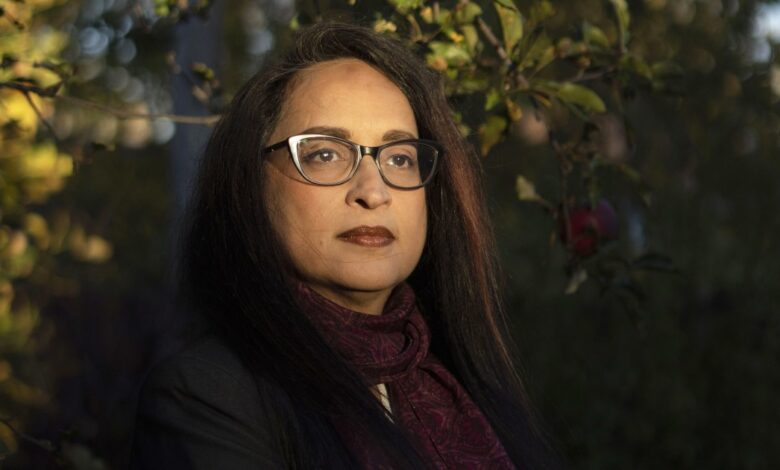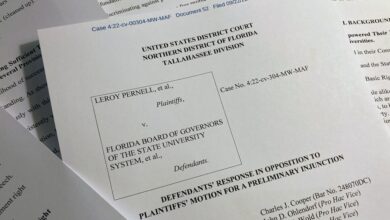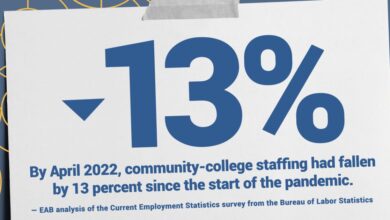A University Tried to Correct Its Pay Gaps. Some Professors Feel Shortchanged.

[ad_1]
Maureen M. Donaghy was feeling optimistic about her chances for a raise when she submitted a pay-equity request that showed she was earning $21,000 and $25,000 less than two political-science faculty members of the same rank.
Donaghy, an associate professor and chair of the political-science department at Rutgers University’s Camden campus, had been at Rutgers longer than either of them. But the pay-equity process that the university’s union and administration had agreed to — one the union described as groundbreaking at the time — left her reeling.
The university recommended a $2,000 pay raise after concluding that $13,000 of the differential she cited could be explained by a regression analysis that takes discipline, rank, title, and other unspecified factors into account. Since she was comparing herself with those who shared her rank and discipline, it was probably the other, unexplained factors that sank her chances of a big raise. She just doesn’t know what those were.
Like other faculty members interviewed, she said the amount is far from equitable, and she wants more information on the factors the university considered to discount so much of the pay differential she had uncovered, and that her dean had signed off on.
“My problem is that this is an untransparent process,” Donaghy said. “It’s hard to even argue that the process is flawed when you don’t know what variables were used.”
Rutgers University has three campuses, in Camden, Newark, and New Brunswick, N.J. In a statement, the university said the pay-equity letters sent to 105 faculty members recommended $1.2 million worth of adjustments that reflect “a detailed analysis of relevant work-related factors for each person who requested a review to determine if they are being paid on an equitable basis.”
Jonathan Holloway, the university’s president, referred to the pay-equity dispute in a September 24 address to the University Senate. He said he was disappointed that efforts to resolve the matter had stalled, but that he had decided to take “a leap of faith” and release the first set of recommendations.
It’s hard to even argue that the process is flawed when you don’t know what variables were used.
“While I still wish we could have agreed upon revisions to the pay-equity assessment process and in so doing put much of this contention and stress to rest, I have decided to move forward,” he wrote in the statement. Because of continuing negotiations over pay disputes, he said he couldn’t comment further. The pay recommendations will have to be approved by the campus chancellors, union negotiators said.
The adjustments underpaid 103 faculty members by a total of between $750,000 and $1 million and were particularly unfair to those at the Camden campus, which enrolls many first-generation students, according to the Rutgers AAUP-AFT, the union representing full-time faculty members.
“The university is undervaluing faculty in Camden and shortchanging our students,” Donaghy said. “If the university wants to promote equity and access in education, they need to distribute resources fairly across campuses.” Faculty members are held to the same tenure and promotion standards across the three campuses, she said, and their salaries should reflect that.
The union’s president, Rebecca Kolins Givan, an associate professor of labor studies and employment relations at the New Brunswick campus, said she’d been optimistic about the “pioneering” approach the union had agreed to with the university. The process called for faculty members who felt they were underpaid to identify higher-paid peers, or “comparables” across the university, and even outside the university.
But nearly two years after those requests were submitted, the initial batch of recommendations from the university reflected continuing inequities, union officials said. In some cases, the university changed the “comparables” to include different faculty members of lower rank, or two faculty members from the Camden campus, where the union says salaries tend to be lower.
The average pay-equity adjustment for Rutgers faculty applicants was 13 percent for those in New Brunswick, 25 percent for Newark, and 7 percent for Camden, according to Jim Brown, an associate professor of English at the Camden campus who heads that campus’s chapter of the AAUP-AFT. One in five Camden applicants received no raises, he said.
“We heard from unions around the country about what a progressive model it was, and how they were going to try to use it,” Givan said. “It’s very sad that a program that was so promising was instead used to further entrench inequities,” she said.
Usually, when faculty members are seeking higher pay, they have to bring an outside offer to the university, said Dana Britton, professor and chair of labor studies and employment relations at Rutgers’s New Brunswick campus.
What’s unusual about the approach Rutgers was taking was that it was having faculty members request individual salary adjustments en masse, based on what their peers were making.

Courtesy of Haydee Herrera-Guzman
Britton said the process was time consuming for faculty members and made many of them uncomfortable. She would rather have seen the university proactively offer across-the-board salary increases for faculty members who were determined, based on an equity audit, to be making less than their peers. That kind of approach was negotiated recently at the University of Massachusetts at Amherst. There, according to the National Education Association, instead of an individual making a case for a raise, “the administration has to make the case for why a person isn’t on a standard pay trajectory.”
Haydee Herrera-Guzman, an associate professor of mathematics on the Camden campus, is one of five plaintiffs in a lawsuit brought against Rutgers that accuses the university of paying women less than equally qualified men. While that lawsuit focuses on gender inequities, the salary-adjustment plan the university agreed to included applications from those who argued that they were underpaid because of their race or the campus they worked on.
“It’s not even clear what formulas or criteria were used” to change the faculty members applicants were compared with, or the amounts they should be compensated. Herrera-Guzman said. Those she identified made between $24,000 and $42,000 more than her. Her suggested raise: $8,000.
Deepa Kumar, a professor of journalism and media studies at the New Brunswick campus, is another plaintiff in the lawsuit. In the union’s press release, she criticized the way the university changed some of the faculty members the applicants were compared with.
“If you take out, for example, male comparators and replace them with lower-paid female comparators, you’re simply compounding the problem of gender pay inequity,” she said.
[ad_2]
Source link






